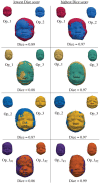Developing and testing an algorithm for automatic segmentation of the fetal face from three-dimensional ultrasound images
- PMID: 33391808
- PMCID: PMC7735327
- DOI: 10.1098/rsos.201342
Developing and testing an algorithm for automatic segmentation of the fetal face from three-dimensional ultrasound images
Abstract
Fetal craniofacial abnormalities are challenging to detect and diagnose on prenatal ultrasound (US). Image segmentation and computer analysis of three-dimensional US volumes of the fetal face may provide an objective measure to quantify fetal facial features and identify abnormalities. We have developed and tested an atlas-based partially automated facial segmentation algorithm; however, the volumes require additional manual segmentation (MS), which is time and labour intensive and may preclude this method from clinical adoption. These manually refined segmentations can then be used as a reference (atlas) by the partially automated segmentation algorithm to improve algorithmic performance with the aim of eliminating the need for manual refinement and developing a fully automated system. This study assesses the inter- and intra-operator variability of MS and tests an optimized version of our automatic segmentation (AS) algorithm. The manual refinements of 15 fetal faces performed by three operators and repeated by one operator were assessed by Dice score, average symmetrical surface distance and volume difference. The performance of the partially automatic algorithm with difference size atlases was evaluated by Dice score and computational time. Assessment of the manual refinements showed low inter- and intra-operator variability demonstrating its suitability for optimizing the AS algorithm. The algorithm showed improved performance following an increase in the atlas size in turn reducing the need for manual refinement.
Keywords: craniofacial abnormalities; image segmentation; three-dimensional ultrasound.
© 2020 The Authors.
Conflict of interest statement
The authors declare no competing interests, financial or otherwise.
Figures






Similar articles
-
Automated segmentation and measurement of the female pelvic floor from the mid-sagittal plane of 3D ultrasound volumes.Med Phys. 2023 Oct;50(10):6215-6227. doi: 10.1002/mp.16389. Epub 2023 Apr 6. Med Phys. 2023. PMID: 36964964
-
Multi-atlas segmentation of the whole hippocampus and subfields using multiple automatically generated templates.Neuroimage. 2014 Nov 1;101:494-512. doi: 10.1016/j.neuroimage.2014.04.054. Epub 2014 Apr 29. Neuroimage. 2014. PMID: 24784800
-
Minimally interactive placenta segmentation from three-dimensional ultrasound images.J Med Imaging (Bellingham). 2020 Jan;7(1):014004. doi: 10.1117/1.JMI.7.1.014004. Epub 2020 Feb 22. J Med Imaging (Bellingham). 2020. PMID: 32118089 Free PMC article.
-
A framework for quantification and visualization of segmentation accuracy and variability in 3D lateral ventricle ultrasound images of preterm neonates.Med Phys. 2015 Nov;42(11):6387-405. doi: 10.1118/1.4932366. Med Phys. 2015. PMID: 26520730
-
Fully automated lesion segmentation and visualization in automated whole breast ultrasound (ABUS) images.Quant Imaging Med Surg. 2020 Mar;10(3):568-584. doi: 10.21037/qims.2020.01.12. Quant Imaging Med Surg. 2020. PMID: 32269918 Free PMC article.
Cited by
-
Craniofacial phenotyping with fetal MRI: a feasibility study of 3D visualisation, segmentation, surface-rendered and physical models.BMC Med Imaging. 2024 Mar 1;24(1):52. doi: 10.1186/s12880-024-01230-7. BMC Med Imaging. 2024. PMID: 38429666 Free PMC article.
-
Fetal face shape analysis from prenatal 3D ultrasound images.Sci Rep. 2024 Feb 22;14(1):4411. doi: 10.1038/s41598-023-50386-9. Sci Rep. 2024. PMID: 38388522 Free PMC article.
-
Automated craniofacial biometry with 3D T2w fetal MRI.PLOS Digit Health. 2024 Dec 30;3(12):e0000663. doi: 10.1371/journal.pdig.0000663. eCollection 2024 Dec. PLOS Digit Health. 2024. PMID: 39774200 Free PMC article.
-
Automated Craniofacial Biometry with 3D T2w Fetal MRI.medRxiv [Preprint]. 2024 Aug 14:2024.08.13.24311408. doi: 10.1101/2024.08.13.24311408. medRxiv. 2024. Update in: PLOS Digit Health. 2024 Dec 30;3(12):e0000663. doi: 10.1371/journal.pdig.0000663. PMID: 39185514 Free PMC article. Updated. Preprint.
References
-
- Benoit B, Chaoui R. 2005. Three-dimensional ultrasound with maximal mode rendering: A novel technique for the diagnosis of bilateral or unilateral absence or hypoplasia of nasal bones in second-trimester screening for Down syndrome. Ultrasound Obstet. Gynecol. 25, 19–24. (10.1002/uog.1805) - DOI - PubMed
LinkOut - more resources
Full Text Sources
Research Materials

